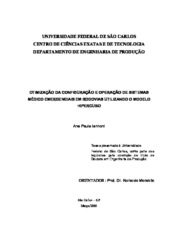Otimização da configuração e operação de sistemas médicos emergenciais em rodovias utilizando o modelo hipercubo.
Abstract
The purpose of this study is to develop effective methods to analyze the configuration and
operation of the emergency medical systems (EMS) on highways. Due to the stochastic nature of
these systems, especially in the arrival and assistance processes of the emergency calls, we apply
the Hypercube Queuing Model to evaluate the performance measures of the system. This is a
well-known model in the location literature, which is based on spatially distributed queuing
theory. The EMS on highways operate within a particular dispatching policy which considers
that only some ambulances in the system can travel to certain regions (partial backup) and
multiple dispatch of ambulances to respond to certain calls. In this study we extend the
Hypercube model to deal with these situations. Since the Hypercube model is a descriptive
model, we also develop a Hypercube embedded genetic algorithm to create a prescriptive
approach to optimize the configuration and operation of EMS on highways. This approach can
support decisions at the strategic level, for example, the location of ambulances along the
highway and the primary response area to each ambulance, as well as, decisions on the
operational level, for example, the optimal dispatch policy of ambulances to respond to the
emergency calls and the coverage area to each ambulance (if the system configuration can be
modified according to the operational conditions of the week or the day). In order to evaluate the
performance of the proposed approach, we conducted experiments using the data of two realsystems:
the EMS Anjos do Asfalto (Presidente Dutra highway) and EMS Centrovias (portions of
the highways Washington Luis, Eng. Paulo Nilo Romano e Comandante João Ribeiro de Barros)
in São Paulo State. The results show that the approach is effective to support planning and
operation decisions in such systems.
